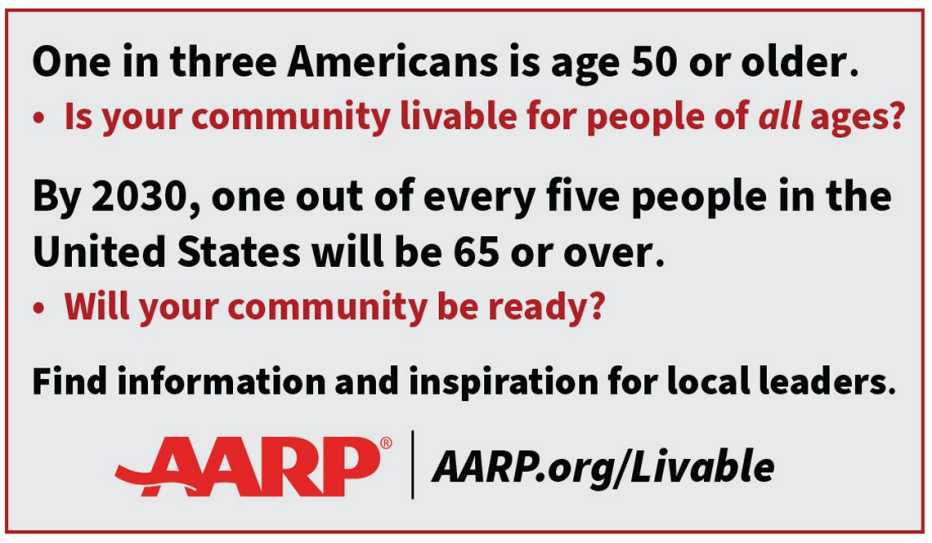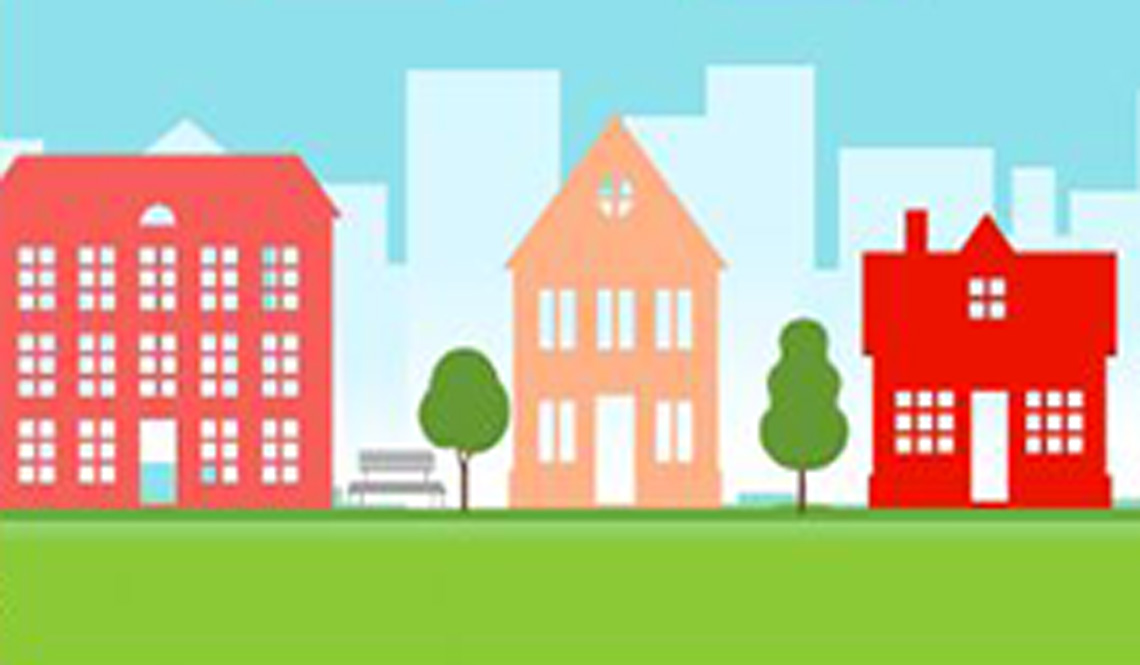AARP Hearing Center


A livable community is safe and secure, contains housing that’s affordable and appropriate, features transportation options, access to needed services, and opportunities for residents to engage and participate in community life. The AARP Livable Communities initiative supports the efforts of neighborhoods, towns, cities, counties and entire states to become more livable and age-friendly for people of all ages.
Some Key Realities
- The vast majority of people age 50 or older are highly engaged in their communities and want to live in their homes and communities for as long as possible.
- Well-designed, livable communities promote and sustain economic growth and make for happier, healthier residents of every age, in all life stages.
- Different generations — from boomers to millennials want similar amenities in their communities.
- Local leaders are best positioned to turn their communities into great places for people of all ages.
The goal is for the communities where we live to be communities for people of all ages and life stages.
Otherwise, roadways intended to facilitate connections become barriers for people who cannot drive.
Cultural activities, visiting with family and friends, shopping and other daily activities are off limits when public transportation is not available and walking is not a safe option.


A home can become difficult to navigate when it hasn’t been designed to accommodate its occupants' changing needs.
Remaining in a community often becomes impossible due to a lack of suitable housing options and access to essential services.
AARP brings the voices of millions into the process.
Our Work
- AARP engages public officials, stakeholders and residents at the local level to plan for and enact community changes that will improve the lives of older adults and people of all ages.
- AARP educates and engages volunteers and residents so they can support positive changes that enable them to remain in their communities and homes.
- As a national leader, AARP serves as an information resource for livability issues, best practices and solutions.
- AARP's education, outreach and advocacy work has focused on building a long-term sustainable presence in communities while driving the change that will improve the lives of residents age 50-plus. Livable community changes, while having a profound impact on residents, require a comprehensive strategy to engage partners, local officials, stakeholders and the community-at-large.
Although every community is different, and we tailor our approach as needed, we are consistent that changes need to benefit older adults and that the best efforts are those that serve people of all ages, income-levels and cultural backgrounds.
We Work Nationally, Nationwide and Locally
AARP develops resources that elected officials, local leaders, policy makers, citizen activists and residents can use to make their communities more livable for people of all ages. AARP staff and volunteers working at the national-, state- and local-level provide direct support in hundreds of communities. These efforts involve:
Meet the Livable Teams
Inspiring Communities: AARP provides "quick-action" grant funding to communities through the AARP Community Challenge (see below) and hosts livability workshops (such as "pop-up" demonstration projects) to inform and inspire local leaders and residents.
Providing Expertise: As recognized thought leaders, members of the AARP Livable Communities team are sought-after speakers and panelists for conferences, including those hosted by the American Institute of Architects, Smart Growth America, the American Planning Association and others.
Providing Resources: AARP presentations and publications showcase great examples and solutions from communities that are leading the way. AARP develops online and print resources about livability topics and provides in-person assistance to help local leaders and community partners achieve positive change.
Informing Policy: AARP's advocacy work promotes model legislation and includes efforts to adopt Complete Streets legislation at the federal, state and local levels; transportation planning, coordination and funding that addresses the needs of all residents; and housing design standards that make homes accessible, easier to use and more livable for people of all ages.
Engaging and Mobilizing Residents: AARP staff and volunteers work with local partners and stakeholders — including mayors, planners, community councils, funders, municipal staff and others — to engage residents. AARP collects information about what’s important to residents, shares it with decision makers, and provides local leaders, advocates and residents with guidance and tools for taking action.
We Inform and Inspire Communities
- AARP Community Challenge Grants: Launched in 2017, AARP Community Challenge grants help towns, cities, counties and neighborhoods make immediate improvements and jumpstart long- term change. The challenge requires working on a fast timeline, typically four months. During the first two application periods, nearly 3,000 proposals were received from nonprofit organizations and government entities. Challenge grant funds have been used to build accessible “tiny houses” for older adults; install artistic crosswalks, murals, benches and directional signage; transform underutilized public spaces and more. AARP.org/CommunityChallenge
- AARP Network of Age-Friendly States and Communities: Learn how a city, town, county or entire state can join this action-oriented, community-driven program. (Check out the member list to see which communities have already joined.) AARP.org/AgeFriendly
- AARP Livable Communities e-Newsletter: Created for community “influencers” — elected officials, planners, municipal staff, placemaking pros, local leaders, policy makers, citizen activists and residents — our multi award-winning weekly e-newsletter contains a mix of best practices, research, resources, slideshows, interviews, how-to’s, news and information about age- friendly efforts from places near and far. AARP.org/LivableSubscribe
- AARP Livable Communities Website: Our award-winning website (you're on it right now) is curated for use by elected officials, local leaders, planners, community volunteers, livability experts, advocates and anyone who wants to make their community more livable for people of all ages. AARP.org/Livable
- AARP Livable Communities Library: All of our publications are free to order or download. Check out the ever-growing collection. AARP.org/LivableLibrary
- AARP Livability Index: A free, interactive, data-driven tool developed by the AARP Public Policy Institute, the index tracks dozens of policies and indicators to calculate the livability of a state, county, town, city or street. Find a score by entering an address, zip-code, municipality or location name. AARP.org/LivabilityIndex
- AARP Community Surveys: Download a free, customizable survey template that can be used to ask residents how they feel about where they live. AARP.org/Livable-Survey
Connect with us by email: Livable@AARP.org.
Page updated March 2022































































